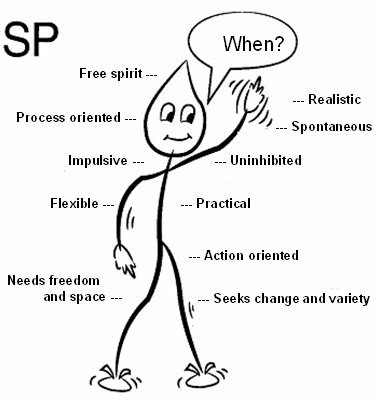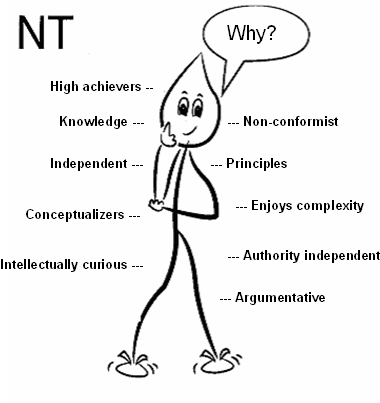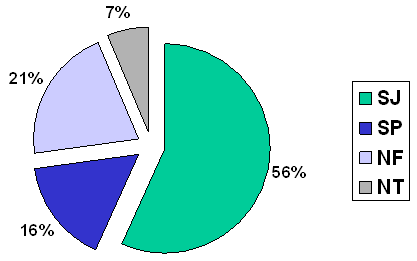University of Florida
Gainesville, FL
In a previous article for Audiology Online, I presented issues and considerations relating to the personality of hearing impaired patients. It is now known that accommodating differences among patients facilitates their improved perception of their impairment and promotes treatment effectiveness.
The methods presented in the earlier paper suggested use of the Keirsey Temperament Sorter II (KTSII), a modification of the Myers-Briggs Type Indicator. The KTSII helps the clinician understand the personalities involved, and facilitates adaptation of treatment protocols to meet the specific needs of the patient. The KTSII is a commonly used personality test, available in many countries and translated into various languages. The KTSII is available on line at www.keirsey.com.
In the KTSII model, there are four different personalities to be considered; Sensing-Judging (SJ), Sensing-Perceiving (SP), Intuitive-Feeling (NF), and the Intuitive-Thinking (NT).
Significant proportions of the adult hearing impaired population are SJs, individuals with logistical intelligence, clear objective practicality, and they like to maintain control over situations. Figure 1 summarizes the overall characteristics of SJs with specific descriptions useful in the informal identification of patients (Kroeger, 1991).
Figure 1. The SJ personal Style (Kroeger, 1991), Bayne (1995)

SP individuals are tactically intellectual and are very good with crisis management. SPs are tolerant of difficulties and their own shortcomings and those of others. However, SPs generally do not tolerate long procedures. A tolerance of imperfection is why accuracy in procedure is not of particular importance to the SP.
Figure 2. SP personal Style (Kroeger, 1991), Bayne (1995)

NF individuals are the abstract cooperators of the world. They have difficulty staying on task and usually have several projects going at the same time. These individuals are diplomatic in their interactions and have an intense need for harmony in their world. In their effort to maintain harmony, they harbor a theoretically impossible need for everyone to be happy at all times. Figure 3 presents the specific traits of the NF personal style as offered by Kreoger (1991) and Bayne (1995).
Figure 3. NF personal style (Kroeger,1991) and Bayne (1995)

NTs have very high standards and are unimpressed with authority. Often considered the "engineer type" by audiologists, they prefer complexity, strategic thinking and want to be considered logical and ingenious. Figure 4 outlines the NT individual as discussed by Kroeger (1991) and Bayne, 1995).
Figure 4. NT personal style (Kreoger, 1991) Bayne (1995)

Although these are now established personal styles that should be considered for rehabilitative patients as we provide them with diagnostic or rehabilitative services, it must be considered that audiologists also have their own personal style. The audiologist's (or clinician's) personal style can drastically affect the outcome of the procedure and it is often not considered a component of the process.
Clinician Personal Style:
Since the clinician can have a major effect on the outcome of a procedure, particularly rehabilitative treatment. Research has begun to determine the distribution of various personal styles among audiology clinicians. In 2000, a pilot research project was conducted at the Academy of Dispensing Audiologists (ADA) annual meeting in San Diego California, USA. The investigation assessed the personal style of 94 subjects, all practicing audiologists. The results are presented in Figure 5 (Traynor and & Holmes, 2001).
Figure 5. Kiersian Personal Style of Audiologists (Traynor and Holmes, 2001)

More recently, at the 2004 American Academy of Audiology Annual Convention in Salt Lake City, Utah, a study was conducted by Traynor, Huart and Holmes (sponsored by Bernafon) to determine the distribution of personal styles among audiologists. Although the results of this study were inconclusive due to the small number of participants, trends indicated many more SJs than NTs, consistent with the Traynor et al (2001) data. Figure 5 indicates that 56 % of audiologists are SJ types, compared with some 40 % of the general U.S. population. 16 % of audiologists are SPs, compared with 40% in the general population. 21% of audiologists are NF types, while in the general population, the percentage is about half - 11%. NTs are found in the general population at about 5% and among audiologists at about 7%, suggesting that we have about as many NT audiology clinicians as in the general population.
If you are seeing patients consistently and have identified your personality as SJ, SP, NF, or NT at the Keirsey web site (www.keirsey.com), it is possible to monitor your natural clinical behavioral tendencies as you see patients.
If you are a SJ (Sensing-Judging) Clinician:
- Do not expect every patient to be on time.
Since you are highly punctual, you strive for your patients to be on time for their appointments. However, many will not be on time and will cause you to run late or to cut their appointment short. To facilitate the appointed goals of the session in a shorter time or a second appointment will be frustrating for you, but may be necessary to insure the patient has the proper rehabilitative intervention.
SJ individuals often learn the best by outlining a written, step by step rehabilitative intervention program. The nature of the SJ clinician is to want all patients to learn from these multi-step written programs, or to use a group aural rehabilitation program where information is presented efficiently to many patients at the same time. Some personalities, such as the SP or NT do not learn best with these methods and may not care about these carefully thought out programs. They may actually need more individual attention and in-depth information than is offered through group rehabilitative training programs.
Although the natural SJ tendency is toward practicality, NT patients are much more theoretical. NTs will generally take the most time as they require lots of explanation of the principles of amplification and other methods utilized in the rehabilitative process. They want specific details of how the hearing instruments are designed and the significance of these concepts to the rehabilitative process. NT individuals take lots of time. If you are an NF or an SP personality, your natural tendency is to get bored with these patients (NF) or frustrated as to their need for so much information (SP).
As an SJ clinician, you tend towards detail and necessarily verify fittings and document that products fit the patient and meet certain parameters. The tendency, however, for the SJ clinician is to over-evaluate and focus on the procedures (such as real-ear measurement) to insure specific optimal settings. SJs must be careful with their natural tendencies, as some personalities (such as SPs) do not care if their hearing instrument is set perfectly, they will simply adjust to the imperfections and appreciate less time and less focus on the procedure, with more focus on the outcome of the fitting.
As an SJ, the tendency is attention to detail. Problems arise if these procedures do not work or are not accepted by the patient. It is helpful for SJ clinicians cover all possibilities for variance during a rehabilitative or fitting procedure. This extra preparation provides options to the clinician and insures they can manage the patient -- no matter what situation may arise during the session. One must be careful, however not to utilize all options on every one. It is good to have options as it makes SJ's feel in control of the situation, but these options may not be required to do a good job for the patient.If you are an SP (Sensing-Perceiving) Clinician:
- Please put up with long procedures when necessary, especially for SJs and NTs.
The SP clinician has a tendency not to be detail oriented. It is necessary for SP clinicians to insure they have enough detail in the procedure (fittings, counseling, and follow-up) to suit the needs of other personalities. However, if the patient is an SJ, they expect lots of detail and specific written procedures for their adjustment to hearing aids. NTs will require lots of counseling regarding benefits and details of the procedure. The SP clinician may become bored with long step-by-step procedures. However, many patients appreciate these fine details and the extra time that goes into their preparation and implementation. SPs must overcome their tendency toward simplicity and be more prepared for situations as they arise during rehabilitative sessions.
The SP is the most tolerant of all Keirsey personal styles. Perhaps based on their tolerance, rehabilitative intervention and hearing aid adjustments for small concerns or specific situations might seem trivial to these clinicians, specifically when working with more detail-oriented patients; such as SJs or NTs. Thus, adjustments to make the patient's voice sound better or to hear the minister more clearly may seem trivial to the SP clinician, but it could be an important component to success. The wise SP clinician listens to patients closely and carefully considers the situation and the personality of each patient, before dismissing their concerns.If you are an NF (Intuitive-Feeling ) Clinician.
- Be aware -- you will never make all of your patients happy.
The NF clinician has a tendency to require harmony in all relationships while avoiding unfavorable situations at all costs. NF clinicians need to have patient interactions that are as "positive" as is possible, and they do everything to insure they are liked by everyone. It should be noted, however, that good clinicians may indeed disagree with patients sometimes, to facilitate better treatment programs. Disagreeing is not "normal" to an NF clinician. Their tendency is to want to agree and keep harmony in the relationship. NFs like to tell patients what they want to hear, not necessarily what they needs to hear. NF clinicians need to resist their tendency to agree, and they must sometimes present unfavorable information which may contribute to less harmony in the clinical relationship.
As with SPs, NFs tend to bore easily with certain repetitive procedures and rationalize these procedures by contributing minimally to the success of the rehabilitative exercise. Successes of such clinical procedures as real ear measurement, step-by-step written aural rehabilitation procedures or group sessions may be overlooked when their use could facilitate real benefit to patients with other personal styles. It is necessary for NF clinicians to overcome their boredom with certain procedures and conduct them anyway, especially the excessive counseling necessary for NT patients and the detail requirements of the SJs.
The ultimate goal of the NF clinician is to have a harmonious relationship with the patient as this will create a positive, harmonious rehabilitative interaction. These clinicians often serve as advocates for the hearing impaired and are frustrated as to the limits of care provided for some patients. Occasionally, NF clinicians will promise repairs, hearing aid modifications, special warranty items and other specific procedures that cannot be supported by manufacturers. These clinicians need to consider that, healthcare in general, and hearing rehabilitation in particular is a business, with limits to the amount of care, services and products, often defined by the amount paid. These clinicians must prepare for the fact that it may be necessary to present unfavorable information that will cause the relationship to be unharmonious occasionally. NF clinicians may feel like they're the only ones that care and the "system" is unfair to the hearing impaired.
In an effort to get more done, and due to the tendency toward boredom, NFs are prone to doing two or three things at one time. In the office, multitasking may work rather well for things such as phoning and checking e-mails at the same time, but patients appreciate full attention presented toward them. It is not beneficial to work on the phone and the patient at the same time or to be distracted by anything other than the task at had during patient visits. The tendency to multitask while working with a patient needs to be avoided if at all possible, as it reflects poorly upon the quality of service provided.If you are an NT (Intuitive-Thinking) Clinician:
- Perfection is not always necessary.
NT clinicians have a natural tendency toward relentless pursuit of perfection in all they do for their patients. To insure perfection, they over-evaluate and over-verify hearing aid fittings. Additionally, they may counsel patients too much, with considerable background for each procedure. NTs tend to approach problems from a number of different directions to insure the approach taken is definitely the correct one. The result of this need for perfection and review is too much counseling, too many evaluations, too many modifications of hearing instruments causing the fitting to take much longer than some personality patient personality types, such as SPs or NFs can stand.
NTs value authority and feel the need to present their findings and recommendations in an authoritarian manner presenting absolutes and expecting patients to follow their exact recommendations. However, some patients do not do well with authority figures and feel this is not necessary to facilitate their rehabilitative treatment. The authoritarian approach to the situation may not work very well with SPs and NFs, as they tend to prefer a softer, less threatening approach. Thus, it is the wise NT clinician that suppresses the authoritarian presentation and interacts with their patients using their input as well as their clinical judgment rather than simply telling patients what to do.
It is a tendency for NTs to present things with too much detail, offering too much information about too many topics. When they receive professional services, NTs require lots of information to feel confident with the person in charge. These clinicians must make adjustments for their tendencies, providing less in-depth counseling and less procedural complexity for most personality types. Patients, other than their NT patients, do not need to know the background for each procedure, where it came from and why we are doing it. Clinicians must be keenly aware of their own personal styles and how they relate to each patient, and their personal style. When the audiologist's type differs from that of the patient, there is a natural tendency to impose the professional's style onto the patient, potentially resulting in poor interactions and leading to an adverse rehabilitation prognosis, especially regarding hearing aid fittings.
Rather, it is our task as professionals to resist the tendency to make the rehabilitative situation comfortable for us, when, instead, the patient's comfort should be the primary concern.
In summary, clinicians have a personal style, as do their patients. However, the professional must be aware of, and manage, the personal style dynamics as needed, to facilitate a comfortable relationship from the patient's perspective. Clinicians must be careful not to introduce their own personality's negative effects into the rehabilitative situation, and professionals should be able to alter the situational dynamics if difficulties are recognized.
An old Chinese proverb goes......He who knows others is clever, but he who knows himself is enlightened!
References:
Bayne R. (1995). The Myers-Briggs Type Indicator: A Critical Review and Practical Guide. New York: Chapman and Hall.
Kroeger O. (1991). On designing a day. Pre-conference workshop at the IXth Annual Convention of the Association for Psychological Type, 1991.
Traynor RM and Holmes AE. (2001). Personal Style and Hearing Aid Fitting. Presentation to the Annual Convention of the Academy of Dispensing Audiologists, Asheville, NC.
Traynor, R. and Holmes, A., (2002). Personal Style and Hearing Aid Fitting, Vol 6, No 1, Trends in Amplification, Glen Head NY: Westminster Press.

